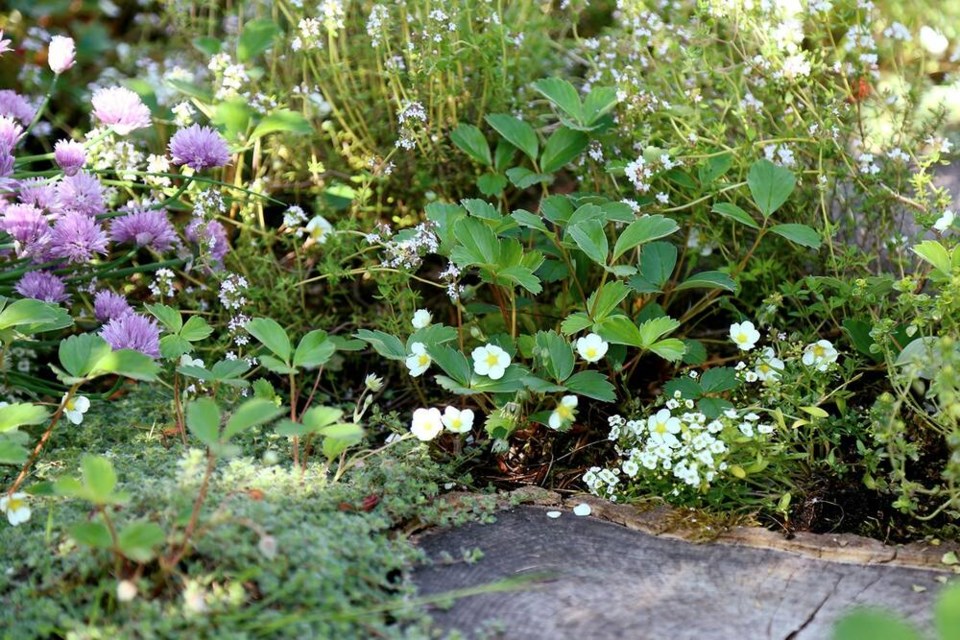Companion plantings, like any element of our home garden, play multiple roles.
Climbing plants and vegetables scale stalky plants, trees and ornaments. Sprawling plants help cool the soil. Tap-rooted plants help aerate and loosen soil. Prickly and smelly plants deter insects. Sappy plants bait aphids. And brightly coloured fragrant plants attract pollinators.
Researchers are discovering that plants and insects communicate using highly evolved methods beyond our purview – tuning into electromagnetic vibration, olfactory signalling, carbon dioxide emissions, infrared imaging, pattern landing, Brix scale sampling and much more. Fascinating stuff.
In general, discussion about companion planting is based around repelling predator insects and/or attracting beneficial ones. Successful pairings advice comes to us from our ancestors, through story. The celebrated “three sisters” companion planting of corn, squash and beans is a classic Indigenous People’s example of a physical and chemical partnership that works beautifully based on nature’s logic. Tall corn stalks trellis bean plants which fix nitrogen in the soil and tether tall stalks in the wind, while prickly squash leaves deter insects while shading the soil and preventing evaporation.
It is worth learning as much as we can of the science behind companion planting, but it is equally important to understand the most important rule of garden planning, namely: insects do not attack healthy plants. This of course is a generalization, as “attack” is subjectively interchangeable with “eat.”
Keeping our plants healthy, then, by feeding and protecting them and their living soil, should be our first priority. Interplanting when possible – that is, avoiding mono-crop rows that make it easy for pattern landers like cabbage moths to find patches of host brassicas upon which to lay their eggs – is another good strategy. Plus, the doing of it inspires an English garden casualness that is more forgiving and lower maintenance than the rigidity of a traditional market garden.
In our space we use unoccupied edges, margins, corners and gutters to plant flowers. In raised food beds especially, I love a tiny patch of pretty – a somewhat tangled mess of yarrow, cosmos, heather, zinnia, sweet alyssum, nasturtiums, miniature iris and blue grass peas, in a calming and peaceful palette of white, pink and blue. The much-loved dwarf marigold, as popular as she is for companion planting, is not companionable to me. Her habit is far too rigid, and the orange screams of chaos and unrest. To each her own.
If I had to pick just one companion flower it would be sweet alyssum, the low growing carpet of tiny white flowers that has almost as many benefits to food and habitat gardeners as there are days in the year, and is equally at home in sun or shade. For a deep dive into alyssum and other companion plants, visit the website and articles of celebrated Pacific Northwest gardener and entomologist Linda A. Gilkeson, or order her fabulous book West Coast Gardening: Natural Insect, Weed and Disease Control, third edition.
Garden centres sell alyssum as an annual, but with a bit of luck and intention, it will naturalize. We leave alyssum to the elements through winter, when the mounds dry up into loofah-like skeletons that break away in the spring.
This season, after an extremely cold winter, we see thousands of baby alyssum popping up in the dwarf fruit tree orchard, self-sown between diverse plantings of native strawberries, thymes, chives, borage and other living mulches.
On that note, I advocate for rich diversity in gardens. In nature as in society, diversity creates a healthy culture, and manages risk and reward organically by leveraging a wealth of skillsets and inherited knowledge in a very companionable way.
Laura Marie Neubert is a West Vancouver-based urban permaculture designer. Follow her on Instagram @upfrontandbeautiful, learn more about permaculture by visiting her Upfront & Beautiful website or email your questions to her here.
For a taste of permaculture, click on the YouTube link below:




